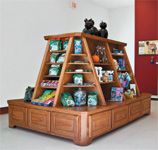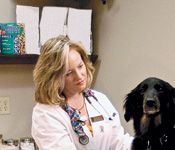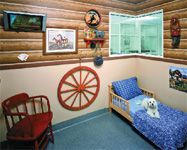Opportunity's knocking
Opening your door to new profit centers can help take the bite out of remodeling and building expenses.
So, you're thinking about building a new hospital or remodeling your facility. A little scary, isn't it? Especially when you think about paying for it. Will the new building make you more efficient? Will it drive new clients and patients to your hospital? Have you created financial models that forecast your projected income and expenses to see if this project will be cost effective? Proceed with caution—new practices can go bankrupt!
Still, it's not all bad news. This new building or remodel can help you generate more money, especially if you find a way to incorporate new products and services into your new facility. Check out some of these common options.
Point-of-purchase displays: It's not rude to point
One fairly simple profit center is a product point-of-purchase display. This display unit goes in your waiting room.
For a point-of-purchase display to be effective, clients must be able to see, feel, touch, and inspect an item they may want to purchase. You can't put it behind the reception desk or under glass; the display must be directly available to clients.

Don't hide 'em: Put retail items where clients can see and touch them, and check the price. (Photo by Dr. Elizabeth Winingham, Chisholm Trail Pet Clinic)
The most effective point-of-purchase displays sit at the point of payment. Placing a display in an area where clients will have their checkbook or wallet out is ideal, because this is where most impulse purchases happen. That's not to say you can't put other displays in the waiting room or in a hallway. Just remember that the best-performing display will be the one near the payment area.
I know of one practice that built an animal-height display unit with toys and chews near the cashier area. As clients came out of the exam room, their dogs would sniff out an item they "wanted" and pick it up in their mouth. The owner would say, "Oh, I guess you want that," then walk to the desk and pay for it! So the pet chose its own reward for visiting the veterinarian. Now that's design planning!
Once you set up a point-of-purchase display, remember that all items need to be visibly priced. Clients don't want to ask how much something costs; instead, they'll just put it down. I also suggest that you affix a foil sticker to retail items with your practice's name, address, and phone number. That way, clients know where they bought the product and where they can go to get more.
Passive marketing: No more "out of sight, out of mind"
Plan to install a small, open-shelf unit in every exam room to passively market retail items. On this shelf, you'll want one each of several different products that you recommend to clients. These aren't prescription items; they're items such as shampoos, vitamin supplements, toothbrushes, and dental chews.

"Why, look-I have it right here!" You recommend certain merchandise to your clients, so why not sell it to them? Educate clients about the importance of the product, pull it right off the shelf to show it to them, and set it on the exam-room table. If they want it, they'll buy it-no hard sell required. (Photo by John Carlson, Carlson Media Inc.)
During an office visit, if a client asks which shampoo he or she should use for a pet or what ear cleaner would be best, the veterinarian or technician takes the product down from the shelf and educates the client on what the product is and why you recommend it.
Once you've "detailed" the product to the client, you set it down on the corner of the exam-room table closest to the exam room's exit. At the end of the visit, if the client wishes to buy the product, he or she will pick it up and walk out of the room with it; if not, the client will leave it. Passive marketing is as easy as that.
Of course, you and your team members will make product recommendations only when they're necessary and appropriate. Clients decide whether they want to buy. And guess what? About 70 percent of the time, the client will pick up the product and walk out of the room with it!
Pet supplies: "Well, since we're here ... "
You may not be a "destination store" for clients to buy pet supplies, but that doesn't mean they won't buy on impulse while they're in your practice. Anything from a small rotating display to an entire room of supplies can meet your needs, depending on your goals. With 100 percent markup on most of these products, they can be a significant profit center.

Turn that frown upside-down: Clients feel better about a painful trip to the clinic if they can buy their pet a little something. (©iStockphoto.com/Craig Veltri)
Collars, leashes, combs, brushes, and nail trimmers normally sell very well. It's more convenient for a client to pick up a new collar or leash at your practice than make a special trip to the pet superstore.
Clients also sometimes feel guilty when they bring in their pets. Just as a pediatrician will offer a child a sticker or a lollipop when he or she gives a vaccination, veterinary clients want to help their pet "feel better" with a new collar, leash, or chew toy. Ever heard comments like, "Poor Fluffy. Since you just got a shot, we're going to have to stop at McDonald's and get you a burger"? Instead of the burger, the client can buy a retail item from your clinic.
Boarding: A kennel of one's own
Done right, boarding can be a significant profit center. Today, practices are moving toward more profitable "pet resorts" instead of traditional boarding. These high-end facilities typically offer deluxe accommodations and themed rooms—Superman, Cinderella, or the Old West (right).

Themed rooms round 'em up: Owners will pay to put their pets in the lap of luxury. But don't overdo it on space; keep your boarding nearly full year-round. (Photo by Larry A. Falke Photography)
One practice built themes around different countries. Clients would book months in advance to make sure their pets would stay in a particular country. Once pets stayed in all the "countries," they could stay free in the country of the client's choice. Pretty creative! Most pet resorts also have pools, activity areas, and value-added services such as play times, vacation journals, and even pet massage. These value-added services can add up: A single night's stay can run $60 or more.
When considering this profit center, focus on occupancy. Survey clients to find out how many rooms you'll need to be at 70 percent occupancy all the time. It's better to have a small facility filled up all the time than a large one occupied only on weekends and holidays.
Grooming: Forget the bride—here comes the groom
Clients love grooming services, but not all veterinarians do. Some have had negative experiences with groomers whose razor burns and cuts on pets ultimately reflected badly on the clinic. Get a skilled, dependable groomer by advertising on job-search Web sites or visiting your local grooming school, and this will make for a wonderful service for your practice.

Bathing 10 feet from the doctor: Clipping and shampooing don't bring in big dollars for your practice. No, it's the groomer's vigilant attention to a patient's skin, eyes, and ears-and consequent medical treatment-that yields a profit. (Photo by Steve Karafyllakis photography)
Most groomers are paid a percentage of the income they generate (normally 50 percent). At this rate of compensation, grooming in and of itself will not be a significant profit center for you. In fact, you'll do little better than break even. However, grooming can become a significant profit center if the groomer picks up on skin, eye, or ear problems that need medical attention. If clients authorize examinations and treatment, that's where the profits start. A good rule of thumb is that, for every dollar a groomer generates for the practice in grooming revenue, another 50 cents should be generated in medical or surgical services.
A 10-foot-by-20-foot room with a table, cages, and a drier should do it. Put it near reception with a window so clients can watch and see that you offer the service.
Medical profit centers: Jump into new medicine—the water's fine
When planning your new practice or remodel, consider medical profit centers as well. Dental suites, special -procedures rooms for ultrasound and endoscopy, in-hospital laboratories, and rehab units have all been successful profit centers in many practices. However, they can be a cost burden if they're not used often enough or well enough.

Look before you leap: Before investing in special-procedures rooms, expensive equipment, and, yes, big rehab pools, make sure you've looked at the income that the equipment, renovation, or design change will bring in. Is it justified? (Photo by Stacey Nigrelli)
When considering a medical profit center, think about how much income you'll need to pay for the space and equipment. There are formulas to calculate this; an accountant or consultant can help. Remember, you will not only have to pay for the piece of equipment, but also for the space and overhead costs. The determining factor is always usage and price. Are you going to use the new equipment often enough and charge appropriately to make it profitable for you, or will it be a drain? (See "The 5 Don'ts of Equipment Buying" on the next article. For more on new profit centers, see "Add Some Bling to Your Bottom Line" in the May 2007 issue.)